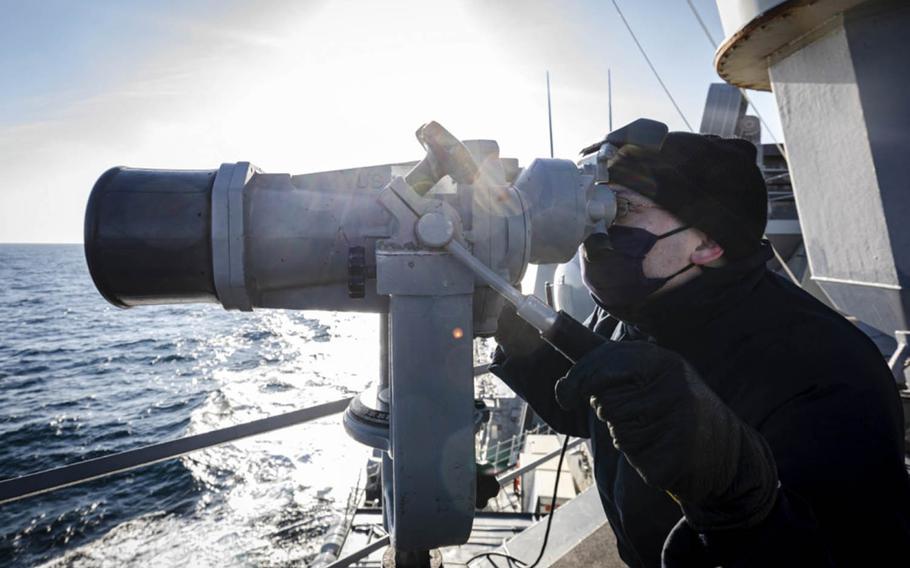
Ensign James Bateman, of Huntsville, Ala., scans the horizon aboard the USS John S. McCain as the guided-missile destroyer sails through Peter the Great Bay in the Sea of Japan, Tuesday, Nov. 24, 2020. (Markus Castaneda/U.S. Navy)
This story has been updated.
YOKOSUKA NAVAL BASE, Japan – The Navy on Tuesday sent another warship to challenge maritime claims in the Western Pacific, this time in an area claimed by Russia, according to a 7th Fleet spokesman.
The guided-missile destroyer USS John S. McCain, based at Yokosuka, “asserted navigational rights and freedoms in the vicinity of Peter the Great Bay in the Sea of Japan,” with a freedom of navigation operation aimed at challenging Russia’s “excessive maritime claims,” Lt. Joe Keiley said in the statement.
Named for Czar Peter the Great, who ruled Russia from 1682 to 1725, the bay is the largest in the Sea of Japan and comprises about 377,600 square miles. The Soviet Union in 1984 claimed the bay as its internal waters, drawing a 106-nautical-mile line from its adjacent coasts to enclose the bay.
After the Soviet Union’s fall, Russia continued the claim, which the Navy said is “inconsistent with the rules of international law as reflected in the Law of the Sea Convention to enclose the waters of a bay,” Keiley said.
“By drawing this closing line, the U.S.S.R. attempted to claim more internal waters — and territorial sea farther from shore — than it is entitled to claim under international law,” he said in the statement.
“By conducting this operation, the United States demonstrated that these waters are not Russia's territorial sea and that the United States does not acquiesce in Russia's claim that Peter the Great is a ‘historic bay’ under international law,” Keiley added.
The Russian Defense Ministry said that when the McCain crossed about 1.2 miles into the bay, its anti-submarine destroyer Admiral Vinogradov threatened the ship via an international communication channel that it would “force (the McCain) out of the country’s territorial waters in a ramming maneuver” if they did not leave, according to the state-owned TASS news website.
“After the warning was issued and the Admiral Vinogradov changed its course, the USS John S. McCain destroyer returned to international waters," the ministry said in a statement, according to TASS.
Keiley called Russia's allegation “false,” adding that “USS John S. McCain was not ‘expelled’ from any nation’s territory.”
“McCain conducted this FONOP in accordance with international law and continued to conduct normal operations in international waters,” Keiley said. “The United States will never bow in intimidation or be coerced into accepting illegitimate maritime claims, such as those made by the Russian Federation.”
Freedom-of-navigation operations are intended to refute territorial claims and demonstrate a right to open navigation, according to the Navy.
Since 2017, the 7th Fleet has steadily increased its freedom-of-navigation operations, which typically target Chinese maritime claims in the South and East China seas. This year, the Navy has sent at least six vessels near contested islands in both seas to challenge Beijing’s claims there.
Tuesday’s was the first U.S. operation challenging Russian claims to Peter the Great Bay since December 2018, according to the Navy.
“As long as some countries continue to assert maritime claims that are inconsistent with international law as reflected in the 1982 Law of the Sea Convention and that purport to restrict unlawfully the rights and freedoms enjoyed by all states, the United States will continue to defend the rights and freedoms of the sea guaranteed to all,” Keiley said in the statement.